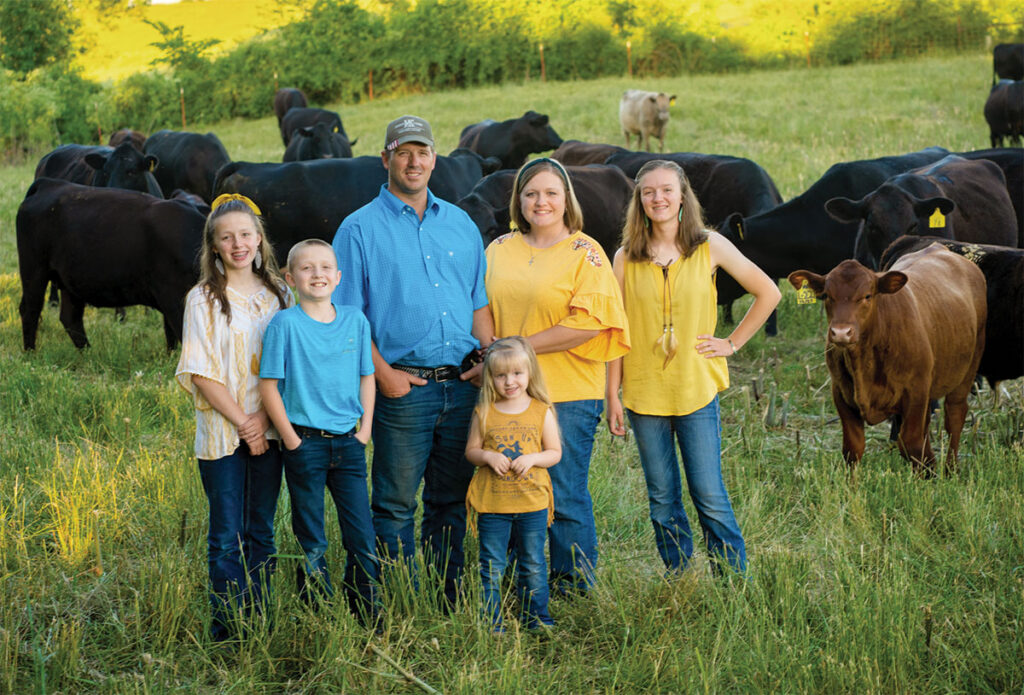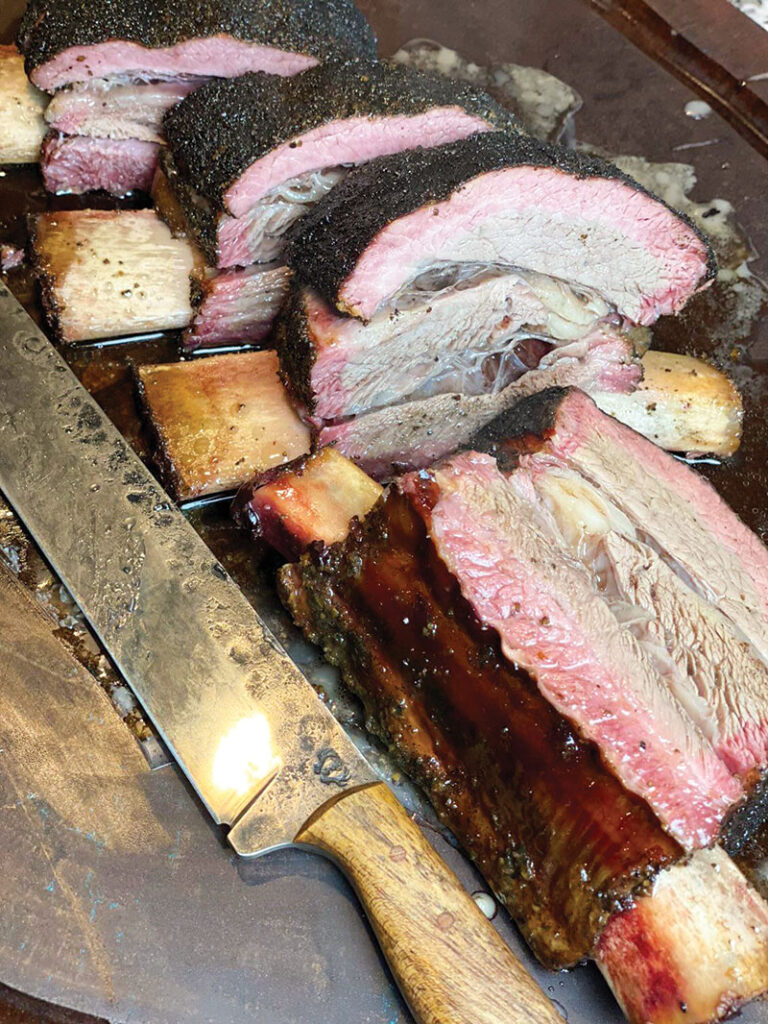
Family change their cattle operation to market beef directly to consumers
GREEN FOREST, ARK. – Marty Armer grew up on a dairy farm just down the road from his current farm near Green Forest, Ark.
He purchased the farm in 2003 while deployed in Iraq as a combat engineer with the U.S. Army Reserves. He and his wife Kristy married after his return from the Middle East, and in 2006, they brought cattle to MK Armer Farms.
MK Armer Farms runs about 45 head of primarily Angus and is in partnership with an additional 45 head with Marty’s sister and brother-in-law (Raymond and Sheila Nance) at their parents’ farm (Yonkipin Legacy Farms, LLC). Raymond and Sheila also have a cattle operation, Nance FarmRS.
Before Marty and Kristy could put cattle on their 106-acre farm, there was a lot of work to be done on fencing and other facilities. Thanks to his full-time job working with Barrows Excavating, he said he had some “perks” when it came to clearing land. After mowing to eliminate brush and other weeds, Marty said the native forages of his pasture made a return. In addition to their farm, the Armers rent an additional 35 acres, and the partnered farm has 160 acres.
Since they started the cattle operation, the Armers have been doing what most cow/calf producers did with their steers, taking them to the local sale. That changed, however, in 2020.
At the onset of the COVID-19 pandemic, Marty and Kristy Armer saw a news report saying there was a shortage of cattle.
“I looked at my wife and said, ‘Honey, there’s not a shortage of cattle. There’s a shortage of people to produce them,” Marty recalled. “That’s how we decided to start selling our animals directly to the consumer.”
Kristy said when they started their farm-to-table endeavor, they were offering halves and wholes but soon realized some customers couldn’t afford a whole or half or didn’t have the freezer space. Marty and Kristy partnered with Raymond and Sheila to add individual cuts of USDA-inspected beef to customers under the Yonkipin Legacy Farm Raised Beef label.
“We still have the wholes and halves, but we can also offer those individual packages of meat or make up smaller bundles,” Kristy explained.
The first year the family offered farm-to-plate beef, eight steers were processed and sold. They now have about 60 head going to beef sales.
“All of our steers now go into the beef program,” Marty explained.
Steers are weaned at around 7 months of age, weighing 500 to 600 pounds, and finished on commodity-based feed.
“They are still in the pasture,” Marty explained. “We don’t force them to eat the grain; it’s all free choice up to the finishing weight. At that point, we will add a little more chopped corn to their diet and do that until processing.”
The target weight for finishing steers is about 1,000 to 1,200 pounds. Calves are typically 13 to 14 months old when processed.
The Armers and the Nances raise all the beef in the meat program.
“Since COVID, for whatever reason, people seem more interested in knowing where their meat comes from and what’s in that meat,” Kristy said. “These cattle have been born and raised on our farms, and we can tell them everything that’s gone into these cattle, and I think that brings the consumers some peace of mind, and I think they want to support local. I feel people are more conscientious of where their food comes from.”

The family retains most of their heifers for future growth and to replace older cows in the herd. Any overflow of females are sold. Heifers go into the breeding program at 14 to 16 months of age.
“Heifers have a lot of developing to do, and they are still developing when you breed them the first time,” Marty said. “You don’t want to take away from that development and growth by breeding them too soon.”
All breeding is a natural cover; bulls always remain with the herds.
“When we were just going to sale barns, we had two separate groups of cows so we could do spring and fall calving,” Marty explained. “Since we’ve started the farm-to-table, it was hard to make 20 appointments at the butcher at once. We decided to start leaving the bull in with the herd and put the two groups together, and we were able to calve throughout the year. It’s easier for us to make the appointments for the butcher, and it spreads it out for the needs of the customer. Some customers want to buy closer in the winter; some buy right before July and in the barbecue season.”
Because there are three herds, Kristy and Marty can rotate bulls frequently and have raised their own replacement bulls.
“We started with bulls from Gene Smith (Smith Registered Angus), and with their good genes and the good gene in the females I bought, we’ve been able to get some bulls out of them. People have different opinions on a good breeding animal, but I’ve picked cows that are solid from the ground up, cows that are good and straight over their top. I want a good, practical animal.”
By selecting those female traits early in their operation, the Armers built the base of their operation for the terminal market long before becoming a farm-to-plate operation.
“We don’t want to push an animal to make weight,” Marty said. “You want them to do it on their own, only providing the materials they need to do it with. The cows mainly get grass. In the winter, they will get hay, but they have free-choice mineral and salt all year. The only grain they receive is if it’s a dry summer, and I still got several cows feeding calves just to help them.
The couple’s four children – 16-year-old Kaitlynn, 13-year-old Lillian, 11-year-old Brycen, and 5-year-old Claire – are active on the farm, with each having roles in the operation. Kaitlynn and Lillian also show steers and hogs at the county fair.
“We couldn’t do it without them,” Marty added.
With the addition of the show pigs, they are looking at the possibility of adding farm-to-table pork.
“Last year, we raised a few hogs, and this year we are too, but we are still figuring it out,” Kristy said. “There’s room there for growth in the future.”
Marty and Kristy said there’s a sense of pride seeing their family’s label going on the beef they produced.
“Knowing you can feed other families throughout the year makes us feel good about what we’re doing and makes us want to do our very best to provide the best quality we can for our customers so they will keep coming back. I never saw us doing farm-to-table; that wasn’t even on our radar. We were happy raising groups and taking them to the sale barn.”
Sales of Yonkipin Legacy Farms beef have seen tremendous growth since its inception. Marty and Kristy hope that growth continues.
“Finding more land and expanding the herd would be the dream,” Kristy said. “Eventually, we want to pull our kids into it, build and hand it down to them; that would be our dream.”







